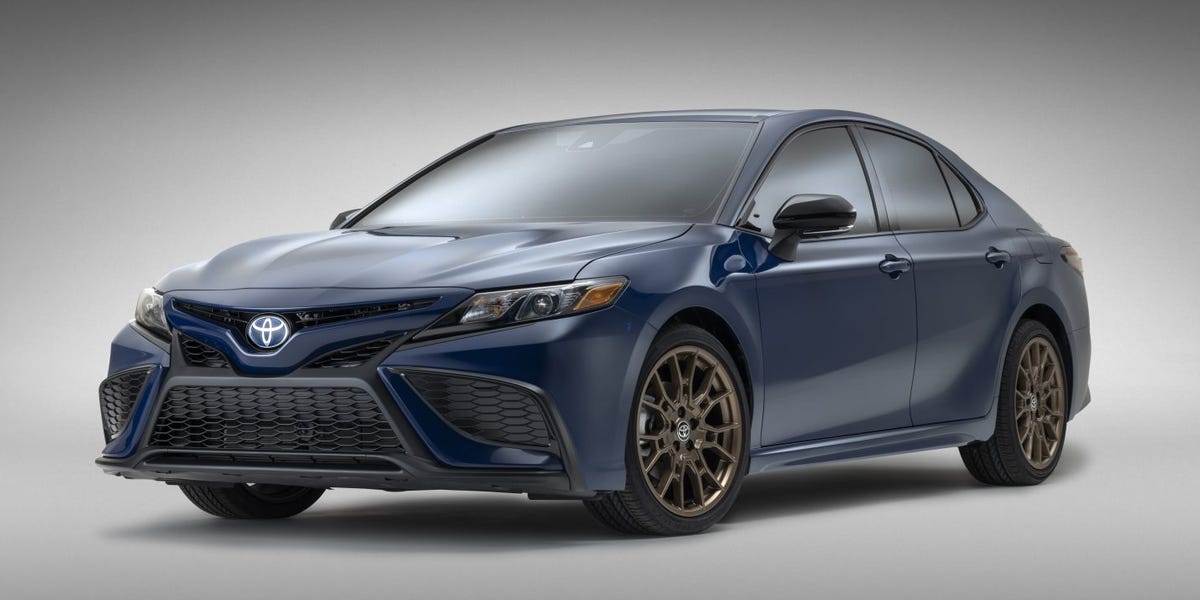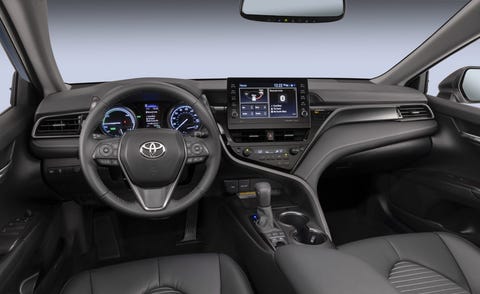2023 Toyota Camry

Overview
The Camry is a mainstay of the midsize sedan segment, which has been losing both entries and sales in recent years as the world has embraced SUVs. Nevertheless, while the market has changed the Camry has continued to top the sales charts as the number-one selling passenger cars, a spot it’s held for the past twenty years. It has a well-earned reputation reliability, and it offers a hybridized version that returns exceptional fuel economy. The current generation of the Camry borders on stylish, especially when optioned with the Nightshade package—which adds bronze wheels for 2023—or the sporty-looking TRD trim. And while many of the Camry’s rivals, such as the Honda Accord and the Hyundai Sonata, have moved to four-cylinder lineups, Toyota’s midsize sedan can still be had with an optional 301-hp V-6. While it’s far from an exciting car to drive, its safety features, economical engines, and spacious interior make it a competent and easy-to-live with daily driver.
What’s New for 2023?
For 2023, the SE trim’s optional Nightshade package adds black headlight and taillight trim to match the black front grille, rear spoiler, mirror caps, and badges. The Nightshade also gains matte bronze 19-inch wheels that, surprisingly, don’t look out of place on it. You can add the package to Midnight Black, White, or Reservoir Blue—a new color. The rest of the Camry lineup gets more driver-assistance technology, including automatic high beams and a forward-facing camera that can read certain road signs and show them on the digital display.
Pricing and Which One to Buy
LE
$27,000 (est)
SE
$29,000 (est)
LE Hybrid
$30,000 (est)
SE Hybrid
$31,000 (est)
XLE
$32,000 (est)
XSE
$33,000 (est)
$34,000 (est)
TRD
$34,000 (est)
XSE Hybrid
$35,000 (est)
We’d select the XLE Hybrid, because we think it is the trim that best reflects what the Camry is best at: being an easy-going family sedan with almost-Lexus accommodations. Driven gently, it delivers excellent fuel economy. It rides well, steers accurately, and its standard leather interior is handsome, roomy, and well-equipped.
Engine, Transmission, and Performance
The standard four-cylinder engine pairs with a silky eight-speed automatic, but its acceleration numbers are disappointing. A less powerful version of that engine works with a battery and two electric motors to power the Camry hybrid, which is no more exciting to drive than the base powertrain. The real gem of this lineup is the velvety 301-hp V-6 that’s available on the XLE and XSE models as well as the TRD variant. We’re also happy to say that we no longer hate driving the Camry. It has a controlled ride and surprisingly responsive handling. The steering is pleasantly weighted and feels substantial when cornering and light when maneuvering in parking lots. We found the Camry’s brake pedal responsive and not too soft, even in the hybrid, in which it must meld friction with regenerative braking (where the energy from braking is used to recharge the hybrid’s battery pack).
Toyota
More on the Camry Sedan
Fuel Economy and Real-World MPG
The whole Camry lineup performed extremely well in the EPA’s tests, and a four-cylinder model did brilliantly in our real-world highway testing. The most efficient nonhybrid Camry models are the LE and SE with the four-cylinder engine, which earned EPA estimates of 28 mpg city and 39 mpg highway; the base LE hybrid earned ratings of 51 mpg city and 53 mpg highway. The hybrid’s upper trims sacrifice some efficiency at the altar of luxury, however, and models powered by the V-6 earned ratings of 22 mpg city and up to 33 mpg highway. A four-cylinder Camry SE returned 45 mpg in our highway test, beating its own EPA rating by 6 mpg—and making it the most economical nonhybrid car we’ve ever tested. It even beat the Camry XLE hybrid we tested by 1 mpg. For more information about the Camry’s fuel economy, visit the EPA’s website.
Interior, Comfort, and Cargo
We’ve driven the Camry in both top-level XLE guise and in its more plebeian SE trim. Both are spacious and comfortable, and the XLE is downright luxurious. However, there’s a serious gap in material quality between the entry-level models and the more expensive versions, and the center section of the dashboard left some of us cold with its uninspired design. The Camry is a large sedan, and there’s plenty of cargo space and interior storage in both its trunk and in its cabin with the rear seat folded. It’s not the best in every storage category, but overall, it’s thoroughly competitive. Toyota relocated the Camry hybrid’s battery from the trunk to beneath the rear seats, so hybrid owners don’t have to sacrifice carrying capacity for the extra mpg.

Toyota
The Car and Driver Difference
Infotainment and Connectivity
Toyota’s touchscreen infotainment system—called Entune 3.0—is standard across the Camry lineup, with an enhanced version available as an option. Entune has loads of features and responded reasonably well to user inputs in our tests, and Apple CarPlay and Android Auto compatibility are standard.
How to Buy and Maintain a Car
Safety and Driver-Assistance Features
We continue to applaud Toyota’s decision to make driver-assistance technology standard on all Camry models. For more information about the Camry’s crash-test results, visit the National Highway Traffic Safety Administration (NHTSA) and Insurance Institute for Highway Safety (IIHS) websites. Key safety features include:
Standard forward-collision warning and automated emergency braking Standard lane-departure warning and lane-keeping assist Standard adaptive cruise control
Warranty and Maintenance Coverage
While rivals such as the Hyundai Sonata and the Kia Optima have longer warranty periods in this class, Toyota holds its own with two years of complimentary scheduled maintenance.
Limited warranty covers three years or 36,000 miles Powertrain warranty covers five years or 60,000 miles Complimentary maintenance is covered for two years or 25,000 miles
Specifications
Specifications
2021 Toyota Camry Hybrid XLE
VEHICLE TYPE
front-engine, front-wheel-drive, 5-passenger, 4-door sedan
BASE PRICE
LE, $28,265; SE, $29,780; XLE, $33,165
POWERTRAIN
DOHC 16-valve 2.5-liter Atkinson-cycle inline-4, 176 hp, 163 lb-ft; permanent-magnet synchronous AC motor, 118 hp, 149 lb-ft; combined output, 208 hp; 1.6-kWh nickel-metal-hydride battery pack
TRANSMISSION
continuously variable automatic
DIMENSIONS
Wheelbase: 111.2 in
Length: 192.1 in
Width: 72.4 in
Height: 56.9 in
Passenger volume: 99 ft3
Trunk volume: 15 ft3
Curb weight (C/D est): 3700 lb
PERFORMANCE (C/D EST)
60 mph: 7.8 sec
100 mph: 19.2 sec
1/4 mile: 16.0 sec
Top speed: 116 mph
EPA FUEL ECONOMY
Combined/city/highway: 46/44/47 mpg
Specifications
2020 Toyota Camry TRD
VEHICLE TYPE
front-engine, front-wheel-drive, 5-passenger, 4-door sedan
PRICE AS TESTED
$33,050 (base price: $32,125)
ENGINE TYPE
DOHC 24-valve V-6, aluminum block and heads, port and direct fuel injection
Displacement
211 in3, 3456 cm3
Power
301 hp @ 6600 rpm
Torque
267 lb-ft @ 4700 rpm
TRANSMISSION
8-speed automatic
DIMENSIONS
Wheelbase: 111.2 in
Length: 194.6 in
Width: 73.1 in
Height: 56.3 in
Curb weight: 3588 lb
C/D TEST RESULTS
Rollout, 1 ft: 0.3 sec
60 mph: 5.6 sec
100 mph: 13.9 sec
130 mph: 25.8 sec
Rolling start, 5–60 mph: 5.8 sec
¼-mile: 14.2 sec @ 101 mph
Top speed (governor limited): 134 mph
Braking, 70–0 mph: 156 ft
Braking, 100–0 mph: 312 ft
Roadholding, 300-ft-dia skidpad: 0.94 g
C/D FUEL ECONOMY
Observed: 21 mpg
75-mph highway driving: 29 mpg
EPA FUEL ECONOMY
Combined/city/highway: 25/22/31 mpg
More Features and Specs



